The Springboard
The Joy of Piezo Disk Pickups for Amplified Coil Springs
Introduction
This paper describes the Springboard, a self-built electroacoustic instrument made from readily available materials, and is a complement to its performance presentation given in the 2007 Toronto Electroacoustic Symposium. This instrument is essentially an extension of a simple, inexpensive device — a piezo disk contact microphone — and the amazing sounds it produces result from a fortuitous choice of readily available materials. It has enabled the discovery of a surprising range of unusual and spectrally complex sounds that I use for music composition, live performance, sound design, and media art inspired by the tape works of Iannis Xenakis, the ideas of John Cage, the (unfulfilled) promise of electronic media, and developments in the fields of radio art and acoustic ecology.
In addition to its role as instrument, the Springboard serves as a convincing pedagogical tool for children and adults, particularly for those interested in handmade electronic music. As an audio transducer the piezo disk’s inherent reversibility (e.g., from an input device to an output device, or from “pickup” to “driver”) enables one to transform the vibrations of any solid object into an audio signal, and vice versa, from audio signal into a vibration. Thus a handheld tape player or radio with an audio output can be used to activate the Springboard. This serves as one of many playing techniques that will be visually and sonically demonstrated; including the bowing of coil springs and wood sticks, as well as the use of friction mallets.
The core of the instrument is an amplified soundboard that enables the vibrations of coil springs and a variety of other objects and material to be made audible. Thanks to a simple piezo contact microphone, the Springboard’s humble constitution belies the richness of its sounds, a signature of the author’s activities in live and recorded works across many art disciplines. Its development process involves inspiration and practical knowledge, and includes a number unforeseen benefits and challenges.
The Springboard is an electroacoustic instrument that I have performed on almost exclusively since 1994 (1). Its invention was inspired by a desire to make new and unusual sounds with coil springs and other materials not normally considered to possess musical or even sonic potential. Use of a piezo disk contact microphone was key to bringing the Springboard to life, and the mic is now a common tool for any practitioner of experimental music, instrument inventors and most of my students.
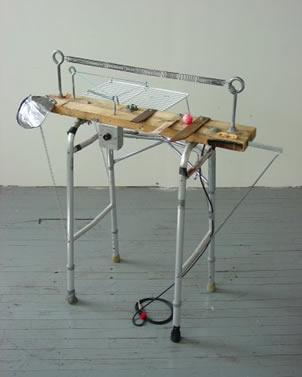
Searching For New Ways to Make Sound
My entry into the world of sound began as a visual arts student interested in ideas and creative opportunities offered by contemporary art, music and — at the time — new electronic media. Setting aside the manual tools of pencils and paintbrushes for the nonmanual ones of video, audiotape and sound synthesis presented a challenge. Over the years, the loss of immediacy in producing audible and visual results continued to frustrate me. As I gained an appreciation for self-built instruments and hardware controllers in the late 1980s, my ignorance of programming and electronics posed an obstacle. The promise of technology to make things never heard and seen possible was handicapped by the lack of direct, immediate, and natural response to physical action and gesture, that pre-electronic instruments and materials had always offered.
In 1990 I found a “work-around” answer to my dilemma in two simple devices: the inexpensive piezo disk contact microphone and the horsehair bow in Hal Rammel’s (2) first instrument invention workshop held at the Experimental Sound Studio (3).
What followed was a lo-tech marriage of the acoustic with the electronic that served as a rewarding if not brilliant point of entry into a new world of possibilities in the exploration of the inaudible and seldom heard potential of nonmusical materials, and their use in a wide range of live and recorded works across the art disciplines and diverse communities of free improvised music, radio art and theater.
Nearly any material and object in the everyday environment has the physical ability to vibrate in the audible frequency range. Once amplified, its potential for art-making is just a matter of the time required to become familiar with the range of behavior of the sound.
Part of the beauty of the piezo contact mic lies in its ability to allow the user to skirt the inherent design challenges facing the acoustic instrument maker: the interrelated material properties of resonance, impedance, mass, etc. Once one is equipped with his or her mixer, amplifier and loudspeakers, the price of a piezo contact mic is negligible, and its ability to act as an aural microscope into undiscovered sonic potential of commonplace objects and materials is open for exploration. From this point any assemblage of thrift-store finds and everyday detritus offers the immediacy of an acoustic instrument’s sound and physicality, producing a sound that some believe to be synthesized. These discoveries are often exciting, if not amazing, and serve as a gratifying tool for both my students and me.
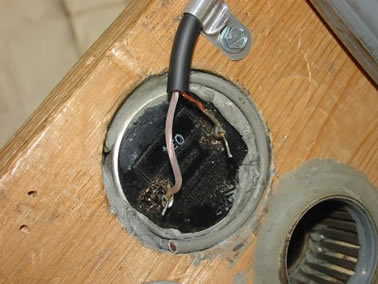
Second-hand Objects
The Springboard’s parts include eyebolts, a thick 2x6-inch board, an aluminum walker, small flat wood sticks, plastic combs, a grill, four narrow coil springs, and one large detachable coil spring. The walker is a thrift store find. It reliably serves its function as an affordable and portable stand better than heavy and expensive drum hardware.
The choice of coil springs as a sound source was inspired by aural encounters with garage doors, and the use of non-musical objects amongst contemporary percussion ensembles, along with the distinctive sound of coil spring reverb units.
A coil spring is similar to a free bar that can be excited at many different points along its length all at nearly the same time. Use of a cello bow for activating the spring produces an inharmonic tone that is distinctly different, and for my disposition, far more compelling than the sound of coil springs being hit or shaken. With practice, bowing coil springs excites and sustains sounds over time with richer harmonic content.
The tones can range from an agglomeration of pitches to an indefinitely pitched drone, often with a large amount of low frequencies, with timbres similar to the trombone and chorused voices. Using two bows at once, one in each hand (Fig. 3) increases the number of springs that are heard at one time, increasing the harmonic density further. Bowing close to the supports as with a sul ponticello (near the bridge) technique brings out the higher partials, enabling bittersweet melodic passages to be made, while a sweep of the bow across the span of the spring shifts the pitch down to the lower fundamental(s). Modulating the bow pressure during a bow stroke varies the frequency response. When one hand is free while the other bows, the spring can be held in various ways to dampen it and emphasize more definite pitches.
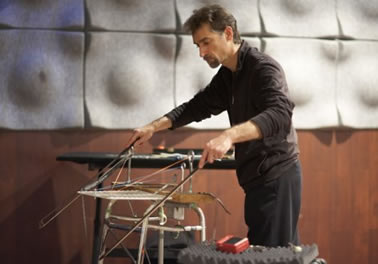
The Springboard serves as a small tabletop, and all its other myriad parts, a multitude of sounds, tones and textures can be manually produced. Given my interests in radio, electroacoustic music and live performance, I seem to have found the device — or assemblage of devices — that enables me to make and use sounds that work in all these diverse yet related fields.
Auxiliary Objects and Effects
In addition to bows, I have found friction mallets made from rubber balls and wood skewers sticks do a wonderful job on the quasi-Daxophone (4) (e.g. paint mixing sticks) part of the instrument. Here are three strips of wood that, thanks to the warp of the board’s top surface, can be pressed down upon to vary their pitch as I bow their edges, eliciting high-pitched squeals with an eerily vocal quality. Friction mallets are a variation on the bow and enable moans, or what some refer to as “whale song” to be made with the wood.
A metal box I mounted to the board houses a 20k-ohm potentiometer for adjusting the “feedback level” on an Oberheim Echoplex Digital Pro™ (5) that I use in Plasticene performances and occasional solo performances. Adjusting the level effects the amount to which the Echoplex’s sample will repeatedly play, looping infinitely at the highest resistance or repeating only once when turned down at its lowest value.
Like Foley effects artists I have an ever-changing collection of auxiliary objects to use on the Springboard. Among these are a pocket radio with a piezo disk plugged into its earphone output and used as a “lo-fi speaker” (Fig. 4), large rubber bands stretched around the eye bolts and grill, a music box mechanism, a pewter goblet, a vibrating massager and a bead chain.
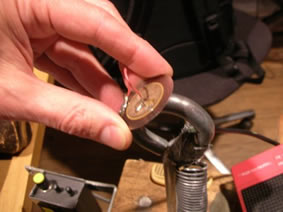
Appearance Follows Function
Leaving the visual appearance of the Springboard unadorned preserves its utilitarian origin, offering information on the nature of its sound that for some may seem inconsistent with the character of its sound output. Audience members sometimes marvel at the simplicity of the instrument after experiencing its rich sound in performance. Absence of visual enhancements maintains it as a sort of didactic tool that demystifies its creation, showing what simple materials and skills are required to begin making instruments of one’s own and hence serving as an invitation to make one’s own instrument. In contexts where the æsthetic effects of advanced technology, high craftsmanship and an aura of fine, precious materials are valued or even exalted, the Springboard’s humble origins and deep sonorities stand as a somewhat contrary æsthetic comment, a reminder of what can be accomplished without a big budget.
Klang aus Müll
Instruments made from commonplace and unwanted materials (Fig. 5) can have unforeseen benefits. For example, one practical concern for the touring musician regards theft, damage and loss. It seems that with its odd, humble appearance the Springboard does not register in anyone thief’s mind as a valuable commodity, let alone a musical instrument. (Left in plain view of the back of my van, parked overnight in the not-so-nice neighborhood streets of Chicago, the Springboard has yet to attract a thief, though I should probably knock wood and stop testing my luck with scavengers.) Joking aside, what is valuable and irreplaceable is the amount of time devoted to learning to play this or any instrument.
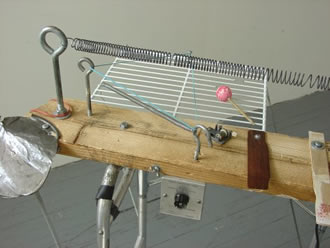
For those interested in attempting to build their own variation of the Springboard, it should be noted that my choice of wood was not the best choice. The cheap construction grade lumber I chose favored mid-range and upper-range frequencies in a way that sounded strident, without much in the bass register. Shaping the frequency response required use of an equalizer in its first two or three years of service until for unknown reasons the Springboard’s sound “matured” or in other words, became fuller and less strident.
An explanation for this change came from one of my graduate students, J.C. Loewe, who informed me that the wood of instruments “opens up” because vibrations made to the wood changes its resonance at a cellular level. I found no scientific explanation for this phenomenon, though most stringed instrument players attest to its occurrence. What I can attest to is that the Springboard is simple in construction yet rich in its potential for complex sounds simply made.
Notes
- An introduction to the Springboard resides online at http://ericleonardson.org/instruments; an earlier article was first published in Experimental Musical Instruments 11/4 (June 1996), pp. 22–23. A forthcoming article by the same title will be published in Leonardo Music Journal Vol. 17, 2007 MIT Press. On-line audio examples are availabe on the author’s website. http://ericleonardson.org
- Hal Rammel is a visual artist, author, musician, instrument inventor, radio host and owner of the record label, Penumbra. http://www.halrammel.com
- Experimental Sound Studio (ESS) is a nonprofit organization in Chicago, founded in 1986 for the production and promotion of innovative approaches to the sonic arts. The mission of ESS is to make audio technology accessible and affordable, as well as to encourage the creative process. http://www.exsost.org
- The Daxophone is an instrument invented by Hans Reichel that enables its player to amplify the vibrations of bowed, or otherwise excited, thin wooden sticks of varying shape and species. Its surprising sounds and the music made with it can be heard in Reichel’s recordings and in his humorous Flash-animated web site. http://daxo.de
- The Oberheim Echoplex Digital Pro™ is now a Gibson product and is still considered a high-end, multi-featured, real-time sample loop device.
Social top